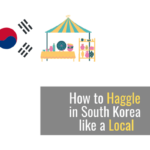Social gatherings in Korean
Bargaining Strategies in Korean
Practical Ideas & Resources
Resources in this section curated by: Hanna LaPointe, Emma Rollo

Traditional markets are windows into lifestyles | News Article
This article discusses how bargaining is often an expected and welcomed practice in Korean markets. It also explains their history, going into depth about how markets were not just a place to exchange goods but also to share news and conversation. Lastly, it highlights particularly popular markets such as 남대문, and how demand for market products has shifted since the growth of modern stores and online shopping. The article does a great job of covering the different bases of Korean markets; learners looking to get form base knowledge would benefit from reading it closely.

Top 10 Must-Know Korean Phrases for shopping | YouTube Video
This video covers not just bargaining phrases, but also other common shopping phrases. The sentences described are frequent in everyday interactions. Learners wanting to get a better grasp on the overall subject can use this video. As bargaining typically happens at the end of an interaction (i.e., after the desired size and color has been found), being able to handle the interaction leading up to that time is important in order to be able to reach that time.

How to Haggle in South Korea and Save Tons of Money | Web Page
This guide, written by a Korean named Minjung, is very comprehensive in its coverage of the background of haggling, the culture around it, tips for successful communication in a variety of market types (such as traditional, electronics, or department stores), prominent markets in South Korea, and ends with a ‘Frequently Asked Questions’ section.
A key interaction the author notes is the 마수걸이 or ‘first sale of the day’; Korean sellers tend to believe that their first sale predicts how the rest of the selling day will go, and thus are more likely to accept a customer’s haggle if they are the first one in the store that day. She also addresses 4 aspects important to successful haggling: 눈치, 기분, 정, and 체면, and how they relate to bargaining with a seller.

Korean culture - What is Jeong?! | YouTube Video
This video by FeelKo describes another important concept related to Korean culture called 정, or jeong. The Korean people have difficulty defining it, but somewhat agree that it is ‘affection, being fond of’. One person explains how in Korean traditional markets, sellers give him more food than he pays for in order to look out for him as if they were related. Another person describes it as an unsaid way of showing those around you that you care about them. When it comes to bargaining, 정 is important because it can explain why sellers may be willing to give a discount and why buyers should be respectful and not try to bargain too much or for too high a discount; each party should be looking out for the other.

Learn the Five Must-Know Phrases for Bargaining in Korean | YouTube Video
YouTuber 한국언니, a expert Korean speaker, explains common bargaining tactics used in Korean shops. She explains both indirect and direct requests (for example, one phrase is ‘It’s so expensive’, suggesting a speaker wants a seller to reduce the cost, while another, ‘Please reduce the price a little bit’ is much more direct with its illocutionary force). This video demonstrates the pragmatic strategies needed for Korean haggling and provides good examples for learners aiming to practice haggling in real-life situations.

Korean-Australians explain the word noonchi/nunchi | YouTube Video
This video by the YouTube channel KOZZIECOM interviews 3 Korean-Australians about the meaning of the word 눈치. The interviewees demonstrate how difficult it is to fully describe, especially when someone isn’t Korean. They generally describe it as being witty, how well you can read a situation, and knowing your place. As the concept is very interpersonal, it is important to have good 눈치 when it comes to bargaining with market sellers.

To haggle or not to haggle in Seoul? | Online Forum
This forum comes from the popular travel website Tripadvisor. In this example, one user begins a forum by asking if haggling for products is required for shopping in Korea. Users who responded tended to agree that although not required, haggling is appropriate in some types of stores (i.e., ones that don’t have marked price tags). One user presents another aspect common in Korean shopping: The idea that shopkeepers believe the first shopper of the day determines how well their products will sell that day. This forum heavily discusses the cultural factors and pragmatic aspects of bargaining and the situations in which it’s appropriate to do so.

Thrifting in Seoul: Tips from a Pretty & Stylish Korean LOL | YouTube Video
This video shows Korean YouTuber Jina Kim going shopping at the popular market 광장시장. She interacts with different shopkeepers in Korean, and as a result, shows common communication patterns between buyer and seller. She also emphasizes that dressing younger helps in getting discounts on items (as sellers will assume a younger person doesn’t have as much money to spend as an older person). Viewers can use this video to practice listening and introduce themselves to common bargaining behavior from a Korean person’s perspective.

Seoul Fake Market Spree! | YouTube Video
In this video, American YouTuber Collin shopping at the popular market 명동시장. While the shopper speaks only in English for the duration of the video, it’s useful in demonstrating many sellers’ openness to haggling and willingness to drop prices, even in a nonnative language. Viewers can learn about common phrases used by sellers to rebuke offers such as “안 돼(요)” (“I can’t (go that low)”), as well as seller body language and sellers’ preference for cash offers over card offers.

[선공개] 외국인의 흥정 시도, 재래시장에서 먹힐까? | YouTube Video
This video is another example showing bargaining. Despite the two tourists not being very familiar with the Korean language, they manage to communicate with and bargain with the sellers at a traditional market. The hosts of the program remark that the phrase they use, “깎아주세요” is a well-renowned bargaining comment. The video is also helpful in showing the atmosphere and typical setup of a traditional market.

Biggest Traditional Market in Korea Vlog! | YouTube Video
This video shows a Korean host, Korean 언니, touring the biggest traditional market in South Korea, 남대문 market. The host provides an overview of the market, its history, and how to navigate the sprawling market effectively. As 남대문시장 is located in the heart of Seoul and has a wide assortment of products, it is popular with native Koreans and tourists alike.
Academic Resources on Bargaining in Korean
Resources in this section curated by: Hanna LaPointe, Emma Rollo
Dyer, J. H., & Chu, W. (2003). The role of trustworthiness in reducing transaction costs and improving performance: Empirical evidence from the United States, Japan, and Korea. Organization science, 14(1), 57-68. https://doi.org/10.1287/orsc.14.1.57.12806
This article discusses how trust between a supplier and buyer may reduce transaction costs in the United States, South Korea, and Japan. The researchers found that the higher the trustworthiness of the buyer was, the lower their transaction costs were. While the experiment took place between car automakers and buyers, their research suggests that this may also be true of typical bargaining in Korea; the trust formed between a buyer and seller in Korean during a transaction involving haggling may play a role in how successful the interaction is.
Jin, B. and Kim, J. (2003), A typology of Korean discount shoppers: shopping motives, store attributes, and outcomes. International Journal of Service Industry Management, 14(4), 396-419. https://doi.org/10.1108/09564230310489240
This article explores several motivations of Korean discount shoppers. While it focuses more on bigger discount brands like Wal-Mart and Costco, the research done is important as oftentimes shopping motivations are similar in traditional markets. Additionally, shopping in local discount stores is still more popular than in bigger brand stores. Some motivating factors are shoppers’ excitement level, shopping satisfaction, repatronage intention, and time and money spent while shopping. Shoppers can also be leisurely (i.e., not extremely motivated), socially-motivated (those who shop for the overall experience), utilitarian (those looking to find the best value for their money) or apathetic (those who spend the least time shopping).
These factors are also important with bargaining and traditional markets. As these markets are extremely popular, there is a wide array of shopper types and motivations. As a result, it is important to be aware of what type of shopper you are and what your motivation is. For example, a more utilitarian shopper may be more inclined to bargain, as they want the best value for what they spend.
Kim, S. H. (2003). Korean cultural codes and communication. International Area Review, 6(1), 93-114. https://doi.org/10.1177/223386590300600107
Suk-hyon Kim dives into several key notions in Korean culture, the one most relevant to bargaining being nunchi, or 눈치. 눈치 describes a person’s ability to ‘read a room’, or, pragmatically, be able to accurately sense the meaning behind someone’s words (i.e., the illocutionary force). Kim calls 눈치 a “major determinant for success in the communication” and that it “[makes] clear the meaning of the communicator’s message and [protects] him from losing the face”. Having good 눈치 is key for any interaction, but especially when regarding bargaining, as shoppers have to find the right balance between communicating their desire for a cheaper price, not going too far in their requests, and accurately reading and responding to the seller’s responses.
Kwon, K. N., & Kwon, Y. J. (2017, July). Two approaches in haggling: A Korean market perspective. [Conference paper] Global Fashion Management Conference, Vienna, Austria. pp. 208-210. http://db.koreascholar.com/Article/Detail/325890
This article provides a general overview of haggling in South Korean markets. The authors interviewed 18 people about their experiences with haggling and found two approaches to the skill: general haggling and forming a relationship with the seller. In general haggling, shoppers often feign disinterest in the product they’re looking to buy or begin haggling from an unreasonably low price and negotiating upward. With the second approach, they try to build closeness with sellers in order to get a deal, such as asking personal questions like where they are from. The first approach emphasizes shopping capital, while the other emphasizes mutual trust.
Pizam, A., & Jeong, G. H. (1996). Cross-cultural tourist behavior: Perceptions of Korean tour-guides. Tourism management, 17(4), 277-286. https://doi.org/10.1016/0261-5177(96)00019-2
Abraham Pizam and Gang-Hoan Jeong studied how different groups of tourists are perceived by their South Korean tour guides when traveling in Korea. They argue that tourists often have their own culture as tourists abroad while also representing their national culture. Americans were perceived as the most different from their Korean and Japanese counterparts, with an increased preference for longer vacation times, as well as being more people-oriented and more adventurous.
One factor measured was bargaining. The results showed that Americans typically paid the asking price instead of bargaining, while both the Japanese and Korean groups bargained. The researchers note that this may be due to the fact that Japanese tourists are more familiar with Korean bargaining norms. In the U.S., bargaining is inappropriate in most shopping situations; it’s not a common act or expectation at markets. As a result, American tourists are more likely to pay the asking price when traveling in Korea. This cultural difference is important to be aware of for language learners looking to increase their haggling skills. Teaching how to bargain may be difficult at first for students that are from cultures where this practice is uncommon or seen as inappropriate.
Robertson, S. (2019). Korean Nunchi and well-being. Science, Religion and Culture, 6(1): 103-109. DOI https://dx.doi.org/10.17582/journal.src/2019.6.1.103.109
This article explains in depth the concept of 눈치, which is the quality that focuses on correctly interpreting and producing indirect communication. The author also brings up the term 기분, or the mood a person or atmosphere has. Maintaining a good 기분 in an interaction requires good 눈치; in a linguistic sense, we can say that successful communication requires accurate interpretation of the illocutionary force of each person’s sentences. Robertson also discusses ‘burdened nunchi’, where the power between interlocutors is uneven and thus the ‘lower’ person is expected to be more tact and careful in social interactions (the example he gives is that the youngest of a group of people may be expected to assemble drinks before a meeting, where the youngest must have good 눈치 to understand this expectation).
The concept of 눈치 is integral to Korean culture, and is tied deeply to social and linguistic norms. As successful bargaining requires face-threatening acts (asking a seller to do something for the buyer and potentially lose out on profit by doing so), it’s important to understand what is appropriate and inappropriate to say during the process. In this way, bargaining, 눈치, and pragmatic competence are important skills to practice.
Sternquist, B., Byun, S. E., & Jin, B. (2004). The dimensionality of price perceptions: a cross-cultural comparison of Asian consumers. The International Review of Retail, Distribution and Consumer Research, 14(1), 83-100. https://doi.org/10.1080/0959396032000154310
These authors studied and compared Korean and Chinese shoppers and their shopping perceptions. Most relevant to bargaining are two values: price consciousness and sales proneness. Price consciousness describes how strongly a consumer wants to pay the lowest price possible for an item, while sales proneness is how strongly a consumer will buy a product based on its price. Korean shoppers tend to be more price-conscious and prefer sales that can be achieved via their bargaining skills. This article sheds light on the motivations behind Korean shoppers’ bargaining behavior, rather than simply explaining that it is a common pragmatic function.
Uchendu, V. C. (1967). Some principles of haggling in peasant markets. Economic development and cultural change, 16(1), 37-50. https://doi.org/10.1086/450268
This article focuses on the general ideas of when it is acceptable to haggle in markets and how to do it. Haggling is a structural behavior system and the more you follow it, the more likely you are to be successful at it. There are two key principles that are mentioned in this article: there is a set range of prices that are acceptable to offer and one should know where to haggle. Learners must know the set range of prices to haggle and if they exceed this range, the seller may react with frustration, anger, or even amusement. This is a representation of the power and social distance that the buyer and seller have. Knowing where to haggle is also essential; if the place has a small number of customers, it is acceptable, if it is a chain or large-scale store, it is not acceptable to haggle.
